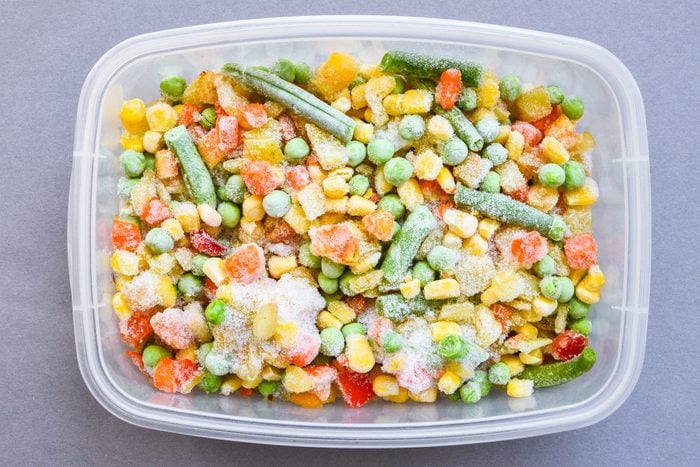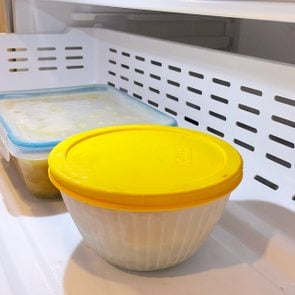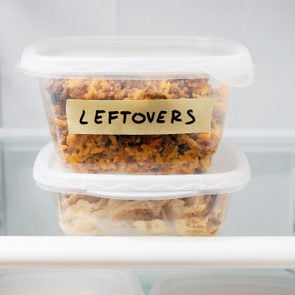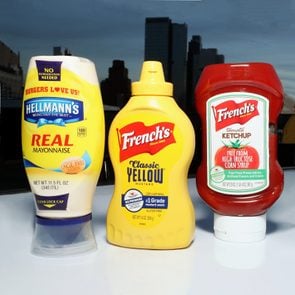What Is Freezer Burn—and How Do You Prevent It?
Updated: Aug. 02, 2023

Ice crystals on your frozen chicken? Shriveled lettuce in your fridge? You might be dealing with freezer burn. Here's what you need to know.
Anyone who’s cooked before (or, you know, microwaved food) knows what a lifesaver the freezer can be. This gem of an invention shelters all kinds of foods—from ice cream and leftover pizza to ready-in-minutes meals—making life much more convenient. It also prevents food waste by helping items last well beyond those recommended sell-by dates. And in the same way that buying non-perishable food in bulk can save money, freezing food also helps out your wallet. After all, the more spoiled food you throw away, the more money you throw away too. But there’s one thing you have to be wary of when freezing food long-term: freezer burn.
You’ve probably seen this phenomenon with frozen food that has ice crystals on it, though it can take other forms too. But what is freezer burn, exactly, and is food in this condition still safe to eat?
What is freezer burn?
Freezer burn is what happens when food loses its inherent moisture, most often due to harsh changes in temperature, improper food storage or an extended stay in the freezer. This evaporation and subsequent dehydration damages the food, causing it to lose its color, texture and flavor, says Jeanette Kimszal, RDN, a registered dietician.
Foods most commonly affected by freezer burn are those with a higher water content (think fish, meats, poultry, produce and ice cream), and it usually occurs when temperatures fluctuate drastically or if the food has been in the freezer for a long period of time. In case you were wondering, everything in the freezer will eventually turn to ice if left in there too long—even if it’s stored correctly.
And believe it or not, freezer burn can happen in the fridge too. “Freezer burn also describes when produce dries up or ‘burns’ in the fridge, normally due to intense temperature changes and inadequate storage techniques,” explains Brian Nagele, CEO of Restaurant Clicks and former owner of Kings Oak restaurant in Philadelphia. “This typically happens to produce left toward the back of the fridge.”
What “improper conditions” cause freezer burn?
Using the wrong storage containers
Not using a vacuum-sealed, airtight storage container? That’s a mistake! “The food has moisture coming off it, which is met by the cold air in the freezer,” says Kimszal. “This will cause a freezing of the moisture, and ice crystals will form on the food.”
Not using your fridge’s special compartments
Preventing freezer burn in produce has a lot to do with your fruit and vegetable storage. “Freezer burn that happens to produce could be due to the fact that this type of food needs a different level of moisture than other foods,” explains Kimszal. “Fridges have special compartments for produce to regulate the temperature they need to stay fresh.”
Leaving your freezer or fridge door open
Freezer burn may also occur if the door is left open, which can cause significant changes in the internal temperature of your appliance … which, in turn, causes significant changes in the internal temperature of your food. Similarly, if your fridge is on the fritz and its temperature fluctuates, your food may take a hit. Here’s what temperature a freezer should be—consistently.
Losing power
How long food lasts in the fridge and freezer without power depends on how long your appliance is without power—and how many times you open and close the doors to get something. Food in a full freezer is typically OK for up to two days, but once the temperature starts to rise, you’ll run into problems. That’s because once it goes back down when the power goes on, the now-present moisture will evaporate and turn to ice.
Signs of freezer burn
You might be surprised to learn that freezer burn comes in many forms. What freezer burn looks like ultimately depends on the type of food and the place it’s being stored. Here’s a quick rundown so you can ID it easily:
- Ice crystals: Yep, this is the common freezer-burn sign you already know. As water evaporates, it has to go somewhere, but since the food is still in the freezer, it usually manifests as ice crystals.
- Color changes: “The effects of freezer burn vary from food to food,” explains Kimszal. “Meat and poultry products will change color, with meat going from red to brown due to oxidation. Poultry will experience color changes as well. The once-pink chicken breast will turn tan.” These foods, as well as fish, may also turn grayish-white and appear leathery.
- Tougher texture: When cooked, foods with freezer burn may be tougher than usual. And you’ll see this not just with meat, poultry and fish but also with starchy foods like cooked grains, pasta, rice and baked goods. You may additionally notice dryness and less volume in the latter foods.
- Dry and shriveled appearance: While produce is higher in water content and therefore likely to form ice crystals, that’s not always the case. Fruits and veggies with freezer burn may appear dry and shrunken, and if you try to cook with them, their texture might seem rigid. “In leafy greens, freezer burn can cause leaves to blacken and shrivel slightly,” Nagele says, “whereas in produce with more body, like tomatoes, freezer burn may cause the food to get soft and mushy.”
Is it safe to eat freezer-burnt foods?
Is freezer burn bad for you? And should you toss foods affected by it immediately, or is freezer burn safe to eat? The good news is that it’s safe to eat freezer-burnt foods, according to both the food experts we spoke with and the USDA. The bad news is that freezer burn might adversely affect a food’s flavor, making it dry and bland. For that reason, you might want to cut away the freezer-burnt portions before or after cooking the food. And the USDA notes that you may need to throw out foods with heavy freezer burn for quality reasons.
Plus, freezer burn depletes a food’s nutritional value. “Evaporation and harsh external conditions can destroy vitamins and proteins in produce,” Nagele explains. And with produce, it can accelerate rotting.
Not sure if your food has freezer burn or has just gone bad? “Microbes like bacteria, yeast and fungi will cause food to smell, letting you know that it has gone bad,” Kimszal says. “Freezer burn, on the other hand, does not always have a specific smell.” In general, here’s how long food is good in the fridge.
How to make freezer-burnt foods taste better
Fortunately, there are ways to make freezer-burnt foods taste better. The key? Your spice rack. “You can improve the taste of freezer-burnt foods with seasonings,” Kimszal says. “Add a little extra garlic, onion or your favorite spice to flavor it. You can add these foods to a soup or stew to give them some extra hydration.”
And if seasoning—even the hottest of sauces—doesn’t cut it, you can always do a hack job. If just a few parts of a food have freezer burn, try cutting those off and salvaging what is left of the food. “It depends on how badly the food is burnt,” says Kimszal. “If it’s a small part that can be cut off, it may not affect the taste. But if it is severely burnt, then it can affect the whole food item.”
How to prevent freezer burn
The most effective way to ensure that your foods don’t taste freezer-burnt is to avoid freezer burn in the first place. Here’s what you need to know:
- Store food in a vacuum-sealed freezer bag or airtight food storage container.
- Wrap food tightly in plastic wrap or tin foil—to keep air out and moisture in—before placing it in an airtight bag.
- Check your packaging for holes or tears, where air can potentially enter.
- Avoid overfilling the bag, and make sure to get all the air out.
- Keep your freezer temperature at 0 degrees or lower, which will ensure food stays frozen and also prevent foodborne illnesses. Freezer burn results from fluctuating temperatures above 0 degrees.
- In the fridge, store produce in the crisper. This drawer keeps the humidity at a different level than the rest of the fridge. “Higher humidity levels are good for leafy or thin-skinned vegetables. Lower humidity levels are good for fruits,” notes Kimszal. “Some crispers have adjustment settings to control the humidity. Crispers without adjustment settings are high-humidity crispers.”
Now that you know all about freezer burn, find out how to defrost a freezer and prevent it from frosting up.
Get Reader’s Digest’s Read Up newsletter for more tips on home, cleaning, travel and tech, plus humor and fun facts, all week long.
Sources:
- Jeanette Kimszal, RDN, registered dietician
- Brian Nagele, CEO of Restaurant Clicks and former owner of Kings Oak restaurant in Philadelphia
- Science Direct: “Food Microstructure and Its Relationship with Quality and Stability”
- USDA: “Freezing and Food Safety”
- University of Minnesota Extension: “The science of freezing foods”
- FoodSafety.gov: “Cold Food Storage Chart”
- Michigan State University Extension: “Refrigerator humidity effects on produce quality”
- FDA: “Are You Storing Food Safely?”



